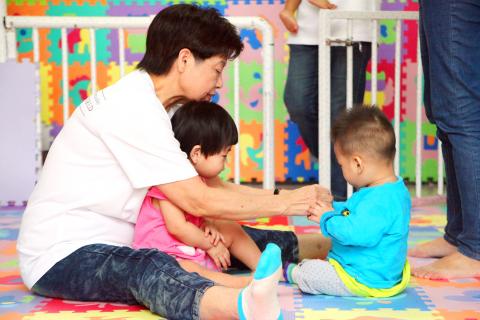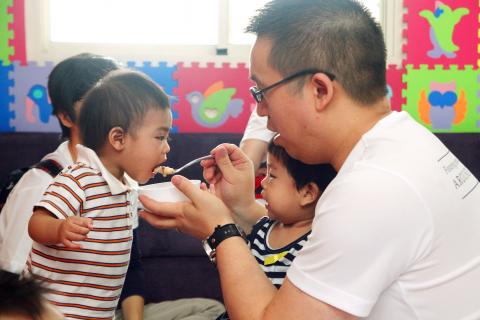In Taipei, the two non-profit agencies that run the foster care system say it’s getting harder to find beds for children.
Since the global economic crisis, the response to World Vision’s traditional recruitment drive of pamphlets and presentations has been shrinking, said Nicole Hsu (徐蒔怡), director of foster care services at World Vision’s Taipei office.
Last year, World Vision received just 10 applications from prospective caretakers in Taipei. Only 7 successfully completed the training program, down from 19 families in 2009 and 28 families in 2008.

Photo Courtesy of the Grand Hyatt Taipei
Taipei’s other foster care services provider — the Taiwan Fund for Children and Families (TFCF, 家扶) at the Southern Taipei City Branch Office (南台北家扶中心) — has not fared better.
The agency could recruit only 4 families last year, down from 10 in 2011.
“It has become much more difficult to find families over the past few years,” said Yen Chung-lin (顏仲崚), a social worker at TFCF.

Photo Courtesy of the Grand Hyatt Taipei
For most prospective foster parents, the main hurdle is financial. Child-rearing is a daunting commitment in tough economic times.
“Many people will first ask me, ‘Will the stipend be enough?’” Yen says.
As a rule, foster care subsidies across Taiwan are slightly above the area’s minimum living expenses. Taipei, an expensive city, offers about NT$18,000 as a stipend for a healthy foster child and NT$20,000 for a child with special needs.
“That covers daily expenses, and health insurance will pay for most medical care. However, you do spend more if you want to give the child more,” Yen said.
For some prospective guardians, hurdles include the required training and the nature of the children who are recommended for foster care. Last year, about 80 percent of children in the foster care system were removed from their biological family because they were victims of abuse and neglect, according to figures compiled by the TFCF.
These children tend to have higher rates of truancy and behavioral problems. About 30 percent of all foster children have physical disabilities or emotional issues.
“We have added requirements and hours to our training program,” said Hsu of World Vision.
“I think that’s crucial for preparing parents and ensuring a standard of care, but it does not help with recruitment.”
NOWHERE TO GO
Taiwan’s foster care system began in Taipei as a pilot program. In 1981, the Chinese Children’s Fund/Taiwan — today known as TCFC — developed a program based on the US model and recruited a handful of families to house unwanted minors.
Two years later, the Taipei City government contracted the agency to operate the first public foster care program in Taiwan.
“Before then, unwanted children were cared for in institutions similar to an orphanage. They were orphans or had been voluntarily relinquished,” said Vera Chen (陳美君), current director of TFCF’s main foster care program in Taipei.
Today, TCFC and World Vision run Taipei’s foster care system together. Their program, like its US counterpart, is mainly intended for removing children from unsafe environments.
But as the caretaker supply dwindles, the system is finding itself increasingly overburdened.
At the moment, the TCFC’s Southern Taipei City Branch Office has 48 active foster homes, a number that is on a decline as parents leave the system faster than they join: 72 percent of foster parents quit after two years, Chen said.
Since January, they have received 20 cases of children needing foster care. So far, social workers have been able to place only 4 in homes.
Last year, they received 83 cases and were able to place only nine — a success rate of 11 percent.
“The need is very high, but I don’t have that many foster families. Even if I had the families, they might not be a match,” Chen said.
“In Taipei, what people lack most is space. Often foster parents don’t have a huge space and can only take young children who can sleep on a cot in the same room.”
Children that cannot be placed are put in institutions, such as Bethany Children’s Home for teens and the Harmony Home, which cares for toddlers and infants including some infected with HIV.
In a recent case, three severely abused and developmentally impaired children were found wandering unclothed at night.
Earlier this month, they were sent to a temporary emergency shelter at Cathwel Service (綠洲家園). The likelihood of a foster placement is slim.
“They are waiting to find a group home that is suitable,” Chen says. “But that will be hard, too — a lot of the institutions are full.”
The upstream impact of a space shortage is that social workers cannot always remove a child from an unsafe home.
Under the current protocol, a social worker first provides preventative care and intervention therapy within the home before referring a child for out-of-home placement. When shelter at foster homes and institutions is scarce, social workers are limited to referring only the worst emergency cases.
ULTRA RECRUITMENT
In recent years, agencies have frantically sought alternate sources of foster care in the effort to build a system that can meet the need.
At TFCF, Chen has tried appealing to the adult children of foster parents, encouraging them to start “second-generation foster care families.”
She is working to recruit relatives of active foster parents, mainly by encouraging active foster parents to get their own relatives involved.
Two years ago, TFCF launched Taipei’s first program for “kinship foster care” — foster care by relatives. So far, they have found 8 “kinship fosters,” placing 13 children.
“The idea is that maybe if there is any blood connection, they are more likely to want to take care of the child,” Chen said.
In 2011, World Vision debuted a similar program at its service centers in Pingtung and Greater Kaohsiung. One hitch they have encountered has been, once more, the matter of the subsidy: Often, the relative who is willing to foster is too closely related to the child to be eligible for a subsidy.
“Without the subsidy, they cannot afford to foster the child,” said Hsu at World Vision.
Under current regulations, stipends can only be disbursed to relatives beyond the third degree. These include great-great-grandparent or first cousins once removed, and do not include grandparents or aunts.
In Taipei, TFCF has also encountered the problem of the subsidy, though Chen sees the program moving in a different direction.
“We’re trying to take it beyond close relatives, to seek out relatives outside the second and third degrees,” she said.
“In an Asian society, families may value even this family connection. South Korea has made this concept work and most of their foster families are distant relatives. I believe it’s viable,” she said.
But as with non-kin recruiting, progress is slow and subsidies are still low. Meanwhile, social workers are more cautious in how they screen these new sources.
“We want to make truly sure that the relative’s family is not dysfunctional in the way the original family was. The children are already hurt. We don’t intend to put them back in the cage.”

In recent weeks the Trump Administration has been demanding that Taiwan transfer half of its chip manufacturing to the US. In an interview with NewsNation, US Secretary of Commerce Howard Lutnick said that the US would need 50 percent of domestic chip production to protect Taiwan. He stated, discussing Taiwan’s chip production: “My argument to them was, well, if you have 95 percent, how am I gonna get it to protect you? You’re going to put it on a plane? You’re going to put it on a boat?” The stench of the Trump Administration’s mafia-style notions of “protection” was strong

Oct. 6 to Oct. 12 The lavish 1935 Taiwan Expo drew dignitaries from across the globe, but one of them wasn’t a foreigner — he was a Taiwanese making a triumphant homecoming. After decades in China, Hsieh Chieh-shih (謝介石) rose to prominence in 1932 as the foreign minister for the newly-formed Japanese puppet state of Manchukuo in today’s Northeast China. As ambassador to Japan, he was to represent the last Qing emperor Puyi (溥儀) at the event’s Manchuria Pavillion, and Taiwan’s governor-general welcomed him with the honors of a state guest. Hsieh also had personal matters to attend to — most

Late last month US authorities used allegations of forced labor at bicycle manufacturer Giant Group (巨大集團) to block imports from the firm. CNN reported: “Giant, the world’s largest bike manufacturer, on Thursday warned of delays to shipments to the United States after American customs officials announced a surprise ban on imports over unspecified forced labor accusations.” The order to stop shipments, from the US Customs and Border Protection (CBP), came as a surprise to Giant, company officials said. Giant spokesman Ken Li (李書耕) said that the CPB never visited the company’s factories to conduct on-site investigations, nor to interview or

The Korea Times announced the results of K-universities Global Excellence Rankings 2026, the nation’s first comprehensive assessment of global performance across its universities. The evaluation was launched to provide an objective analysis of the globalization status of Korean universities and to offer practical guidance for international students choosing institutions in South Korea. KOREA UNIVERSITY RANKS FIRST In the overall rankings, Korea University secured first place with a total score of 144.86, followed by Seoul National University (141.48) and Yonsei University (140.33). Rounding out the Top 10 were Sungkyunkwan University (132.20), Hanyang University (124.83), Sogang University (112.27), University of Seoul (111.10), Ewha Womans